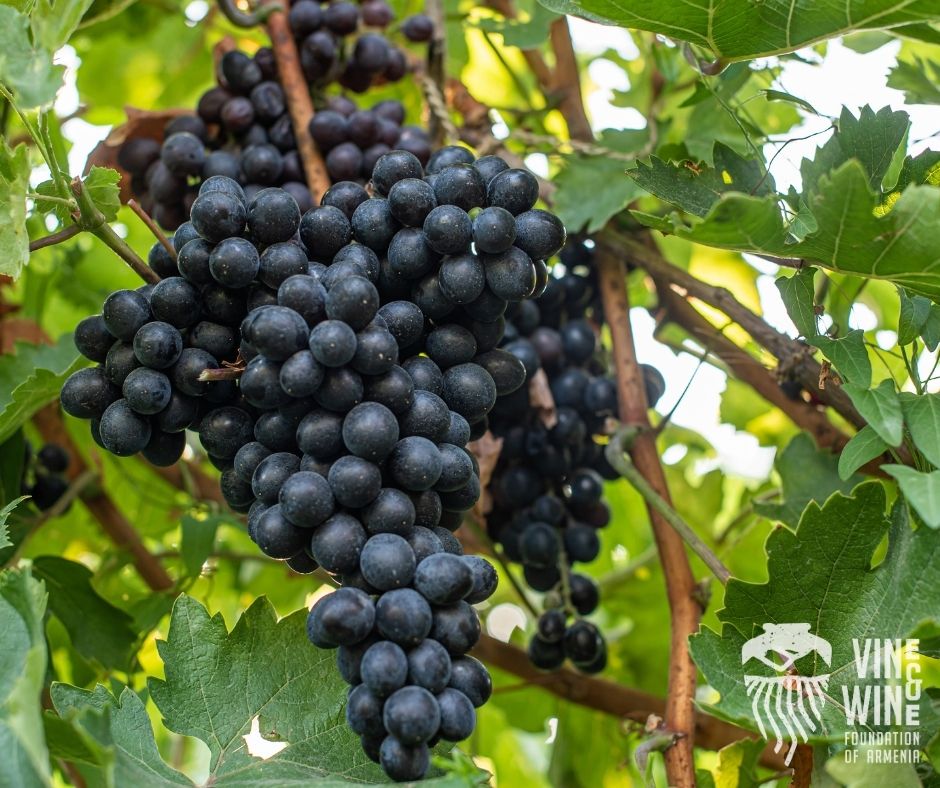Areni
Ampelographic characteristics:
 Sugars – high level of sugars, while maintaining a nice level of acidity; mid-November turns to raisins on the vine. Sugar content – 19,5-23,0 %
Sugars – high level of sugars, while maintaining a nice level of acidity; mid-November turns to raisins on the vine. Sugar content – 19,5-23,0 %
 The plants are of middle height. Leaves are middle-sized, usually round shapes, on the bottom covered with a hairy layer. In autumn the leaves turn bright red. Bunches are medium to large, with densely matured grapes.
The plants are of middle height. Leaves are middle-sized, usually round shapes, on the bottom covered with a hairy layer. In autumn the leaves turn bright red. Bunches are medium to large, with densely matured grapes.

Synonyms:
Black Malahi, Black Areni, Areni Noir.
Resistance to diseases:
 Poor resistance to mildew, medium resistance to oidium and noble rot
Poor resistance to mildew, medium resistance to oidium and noble rot
Vegetative features:
 Technical maturity - end of September, beginning of October (the sum of active t 3400- 3422 O C in 159 days) Shoot maturation is good. Yield – 8-15 t/ ha
Technical maturity - end of September, beginning of October (the sum of active t 3400- 3422 O C in 159 days) Shoot maturation is good. Yield – 8-15 t/ ha
Climate conditions:
 Highland territories are favorable for this variety. The variety is frost resistant and can bare low temperatures up to – 20 O C.
Highland territories are favorable for this variety. The variety is frost resistant and can bare low temperatures up to – 20 O C.
 Wine characteristics:
Wine characteristics:
Areni is a unique grape variety not only for its truly big age but also for its natural
potential. It quite looks like Pinot Noir: it can show up in a full-body structure, brightly
expressed tannins, as well as, coming from different regions of Armenia, it can demonstrate
different colours in wine. Areni is a very flexible variety, and everything depends on the
winemaker’s approach.
Areni produces the most diverse styles of wine: bright, sparkling wines, light rose wines
and powerful reds, with long ageing potential.
Typical aromas of the variety are cherry, black pepper, black tea.
 Historic notes:
Historic notes:
Areni is an indigenous Armenian grape variety, which belongs to the eco-geographical
group of eastern grape varieties. It can be found in almost all winemaking regions of Armenia: it
is especially expended in the western part of Vayots Dzor, by the banks of Aerpa River.
Areni is considered one of the most valuable endemic grape varieties in Armenia. It
grows on its original roots and some of the vines, still found in the territory of the country, reach
the age of 120 years old.
It was proved that this old grape variety comes from the same cave in Areni, where the
oldest winery was discovered (4000 BC). Despite this, the archaeological and genetic
investigations claim its constant cultivation in these territories for millenniums. The DNA
analysis shows no connection with other grape varieties.
Areni can freely consider the visit card of Armenia in winemaking.

